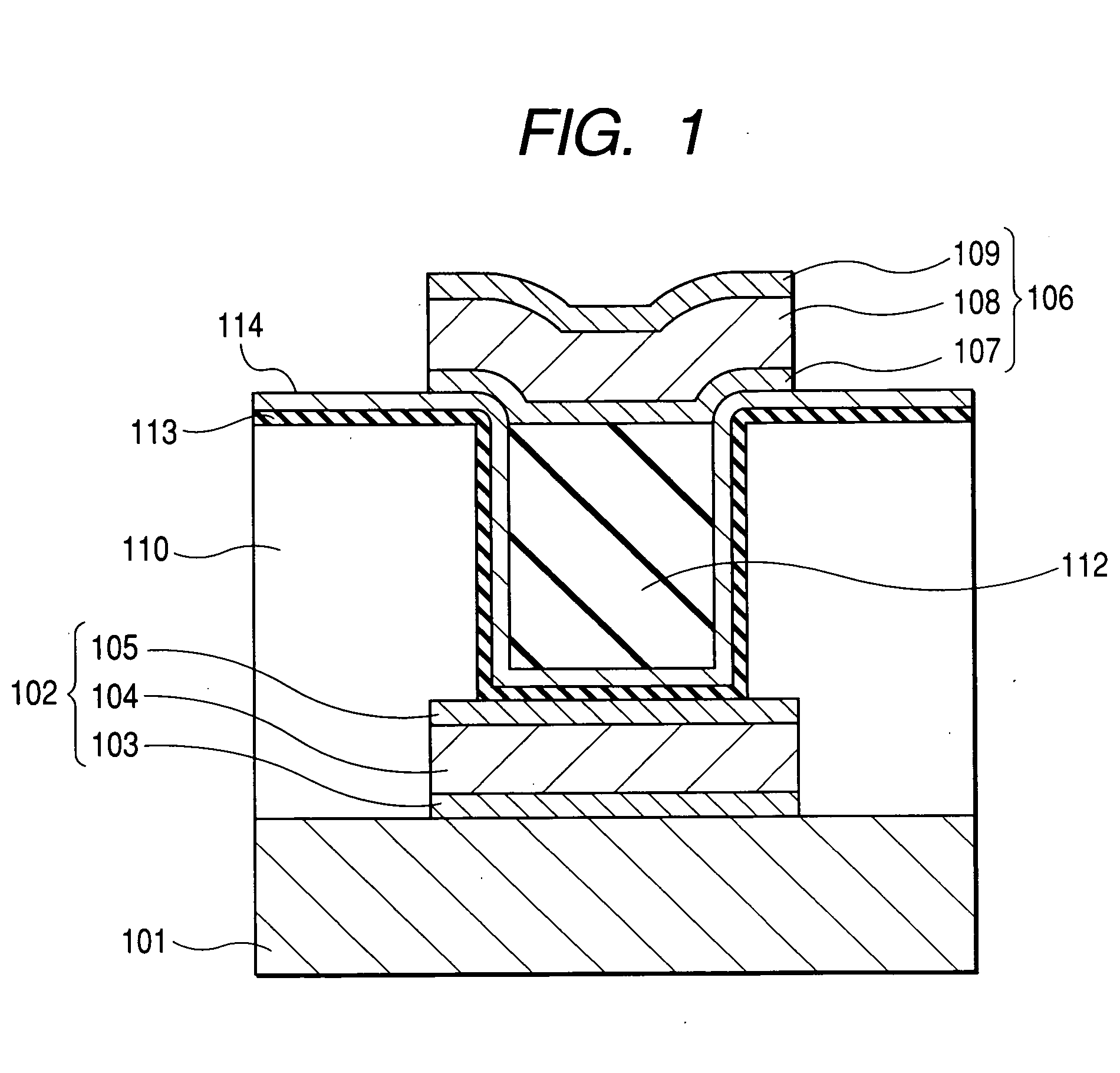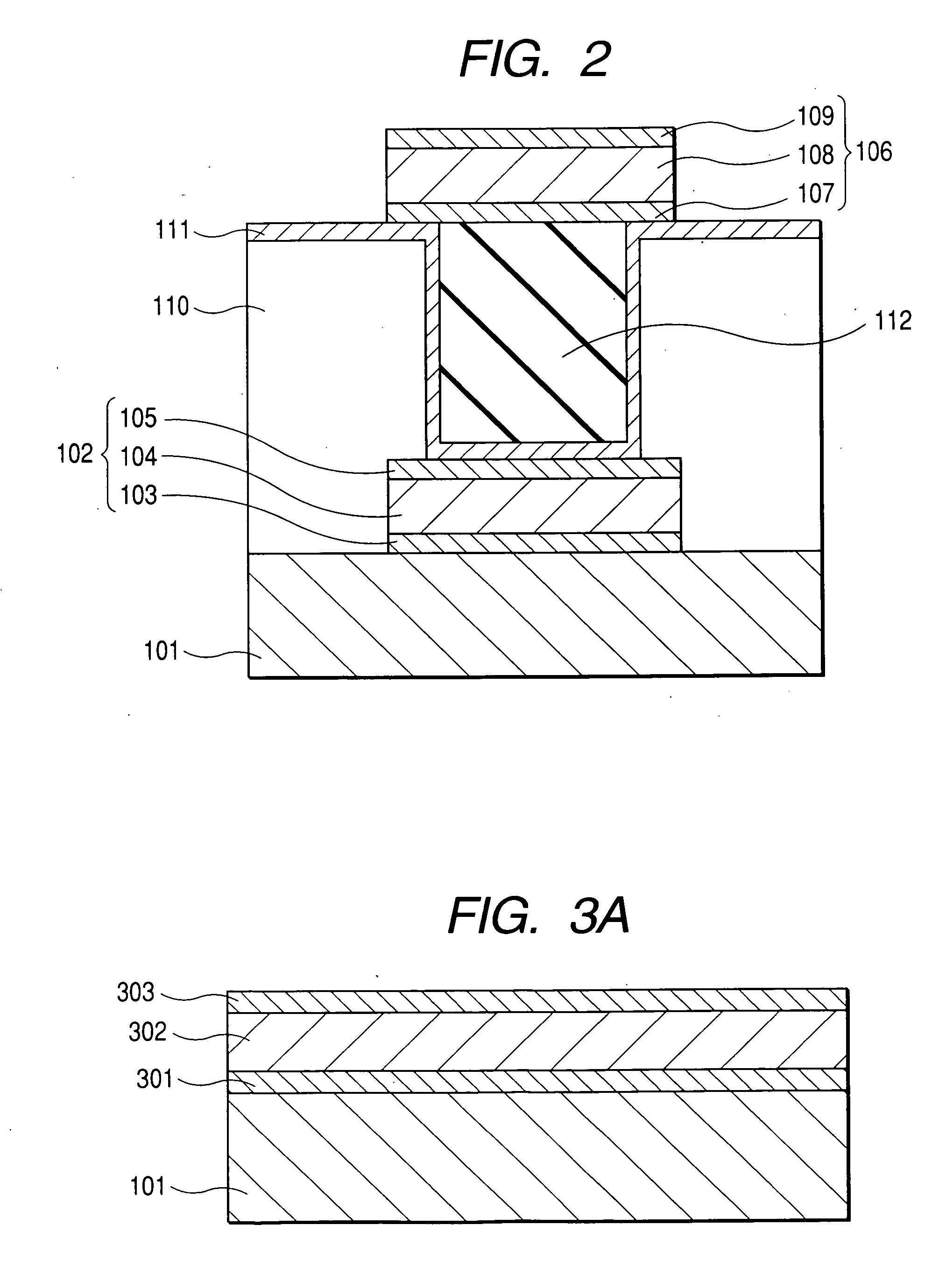Integrated semiconductor device and method of manufacturing the same
a semiconductor and integrated technology, applied in semiconductor devices, capacitors, electrical equipment, etc., can solve the problems of low reliability, defect risk of dielectric large changes in dielectric constant of materials having a high dielectric constant, so as to improve reliability, reduce the number of defects, and reduce the density of defects
- Summary
- Abstract
- Description
- Claims
- Application Information
AI Technical Summary
Benefits of technology
Problems solved by technology
Method used
Image
Examples
embodiment 1
[0035]FIG. 1 is a sectional view of Embodiment 1 of the present invention. A first wiring layer (102) is existent on a semiconductor substrate (101) having an active device formed thereon and consists of a metal layer (104) and upper and lower layers (103, 105) made of titanium nitride as a barrier metal. A second wiring layer (106) is existent above the first wiring layer and consists of a metal layer (108) and upper and lower layers (107, 109) made of a barrier metal. An ordinary interlayer dielectric (110) is interposed between the two metal wiring layers, and an opening is formed in the interlayer dielectric in a portion which will become an MIM capacitor. An aluminum oxide layer (113) and a niobium oxide layer (114) are formed as capacitor dielectrics on the inner wall of the opening. The aluminum oxide layer (113) is an amorphous film having a thickness of 2 nm and the niobium oxide layer is a crystallized film having a thickness of 5 nm. The opening is filled with these capac...
embodiment 2
[0048] A lamination method according to another preferred embodiment of the present invention is disclosed next. Since the principle of the present invention is to carry out temperature correction with the film thickness ratio of aluminum oxide to niobium oxide, it is of no essential significance that aluminum oxide and niobium oxide disclosed in FIG. 1 and FIGS. 3A to 3G are deposited in the mentioned order. Niobium oxide may be deposited first. Further, FIG. 11 shows only the electrode / dielectric laminated structure of the capacitor shown in FIG. 1 which has a three-layer structure consisting of an aluminum oxide layer (401), niobium oxide layer (402) and aluminum oxide layer (403). Also in this case, the present invention can be carried out by setting the ratio of the total thickness of the upper and lower aluminum oxide layers (401, 403) to the thickness of the niobium oxide layer (402) to 0.2 to 1, preferably 0.4 to 0.7.
[0049] When a higher application voltage is used, the alu...
embodiment 3
[0050] Other preferred materials of the niobium oxide layer in the present invention are disclosed next. Although niobium oxide is a dielectric which can be crystallized at 300 to 400° C. specifically, out of simple oxides showing high insulating properties, when its insulation resistance is compared with those of other similar simple oxides, it is slightly lower. To improve this, tantalum oxide was mixed with niobium oxide. FIG. 13 shows the dependence upon mixing ratio of dielectric constant when the crystallization annealing of a mixed film deposited on the 2 nm-thick aluminum oxide film was carried out at 450° C. When the mixing ratio of tantalum oxide was 10% or less, the same dielectric constant as pure niobium oxide was obtained and the desired effect of increasing insulation resistance could be obtained. That is, the niobium oxide layer of the present invention can be mixed with tantalum oxide in a mixing ratio of 10% or less. Also in this case, the present invention can be ...
PUM
 Login to View More
Login to View More Abstract
Description
Claims
Application Information
 Login to View More
Login to View More - R&D
- Intellectual Property
- Life Sciences
- Materials
- Tech Scout
- Unparalleled Data Quality
- Higher Quality Content
- 60% Fewer Hallucinations
Browse by: Latest US Patents, China's latest patents, Technical Efficacy Thesaurus, Application Domain, Technology Topic, Popular Technical Reports.
© 2025 PatSnap. All rights reserved.Legal|Privacy policy|Modern Slavery Act Transparency Statement|Sitemap|About US| Contact US: help@patsnap.com



